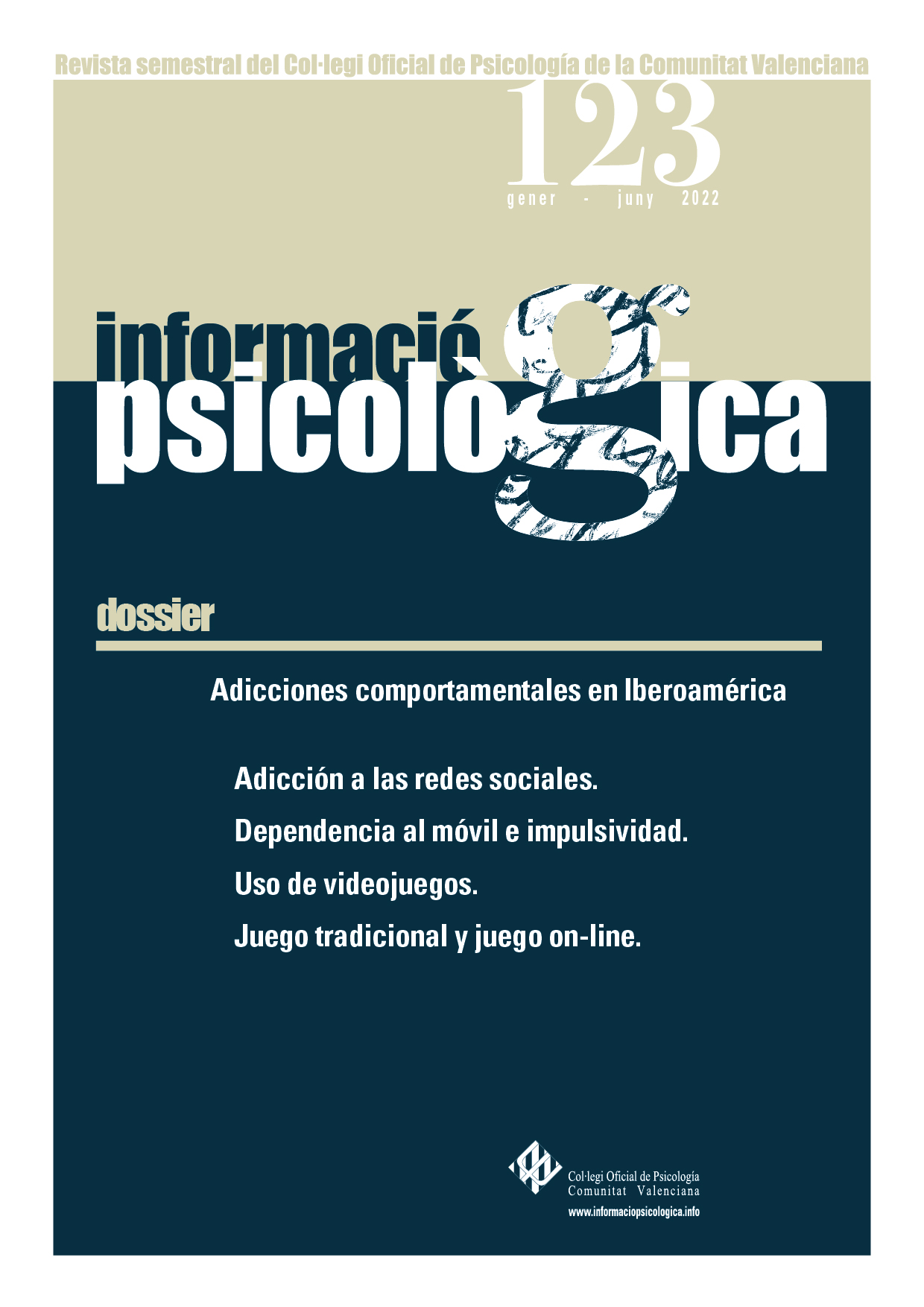Gambling and gambling problems in the province of Mendoza (Argentina): a preliminary descriptive study
DOI:
https://doi.org/10.14635/IPSIC.1929Keywords:
Gambling disorder · Prevention program · Addiction prevention · Adolescence · Online gamblingAbstract
Since the emergence of online gambling, the increase in the incidence and prevalence of gambling disorders has been observed in different countries, as well as changes in the distribution of gambling frequency in different population segments.
The negative consequences of gambling highlight the need for preventive programs appropriate to the characteristics of the population in which they are going to be implemented. Despite not being epidemiological, the purpose of this study is to provide a first approach to the gaming phenomenon in Mendoza in order to adapt the Ludens prevention program.
In the present work, the frequency and differences in involvement in risky gambling and gambling disorder were examined, using the NODS questionnaire, in relation to age, sex and type of gambling. The prevalence indicators replicate similar results to those of other studies, showing higher gaming rates in men and young people.
Downloads
References
American Psychiatric Association. (2013). Diagnostic and statistical manual of mental disorders (5th ed.). Washington, DC: American Psychiatric Association.
Becoña, E. (2004). Pathological gambling: prevalence in Spain. Health and Addiction, 4(2), 9-34. https://doi.org/10.21134/haaj.v4i2.128
Calado, F. y Griffiths. (2016). Problem gambling worldwide: An update and systematic review of empirical research (2000–2015). Journal of Behavioral Addictions, 5(4), 592-613. https://doi.org/10.1556/2006.5.2016.073
Chóliz, M., Marcos, M. y Bueno, F. (2021). Ludens: A Gambling Addiction Prevention Program Based on the Principles of Ethical Gambling. Journal of Gambling Studies. https://doi.org/10.1007/s10899-021-10066-7
Chóliz, M. (2016). Regular el juego para prevenir la adicción: hoy más necesario que nunca. Adicciones, 28(3), 174-181. https://www.redalyc.org/pdf/2891/289145913007.pdf
Chóliz, M. y Herdoiza, P. (2020). Adicciones comportamentales en A. Belloch, B. Sandín y F. Ramos. (Ed), Manual de Psicopatología, Vol. 2 (pp. 522). Madrid: McGraw Hill.
Derevensky, J., Hayman, V. y Gilbeau, L. (2019). Behavioral Addictions: Excessive Gambling, Gaming, Internet, and Smartphone Use Among Children and Adolescents. Pediatric Clinics of North America, 66(6), 1163-1182.
Edgren, R., Castrén, S., Alho, H., Salonen, A H. (2017) Gender comparison of online and land-based gamblers from a nationally representative sample: Does gambling online pose elevated risk? Computers in Human Behavior, 72. 46-56. https://doi.org/10.1016/j.chb.2017.02.033.
Griffiths, M. D., Parke, A., Wood, R., Parke, J. (2006). Internet Gambling: An Overview of Psychosocial Impacts. UNLV Gaming Research and Review Journal, 10(1). Disponible en: https://digitalscholarship.unlv.edu/grrj/vol10/iss1/4
Hubert, P. y Griffiths, M. D. (2018). A Comparison of Online Versus Offline Gambling Harm in Portuguese Pathological Gamblers: An Empirical Study. International Journal of Mental Health and Addiction, 16(5), 1219–1237. https://doi.org/10.1007/s11469-017-9846-8
Husky, M. M., Michel, G., Richard, J. B., Guignard, R. y Beck, F. (2015). Gender differences in the associations of gambling activities and suicidal behaviors with problem gambling in a nationally representative French sample. Addictive Behaviors, 45, 45-50. https://doi.org/10.1016/j.addbeh.2015.01.011
Jiménez-Murcia, S., Granero, R., Giménez, M. et al. (2020) Contribution of sex on the underlying mechanism of the gambling disorder severity. Science Repository 10, 18722 (2020). https://doi.org/10.1038/s41598-020-73806-6
Leeman, R.F., Potenza, M.N. (2012) Similarities and differences between pathological gambling and substance use disorders: a focus on impulsivity and compulsivity. Psychopharmacology 219, 469–490. https://doi.org/10.1007/s00213-011-2550-7
Maqueda, Fátima y Ruiz-Olivares, Rosario (2017). Relación entre juego patológico y consumo de sustancias en una muestra de estudiantes universitario. Salud y drogas, 17(2),17-24. ISSN: 1578-5319. Disponible en: https://www.redalyc.org/articulo.oa?id=83952052002
McBride, J. y Derevensky, J. (2009). Internet gambling behavior in a sample of online gamblers. International Journal of Mental Health and Addiction, 7(1), 149–167. https://doi.org/10.1007/s11469-008-9169-x
Organización Mundial de la Salud (OMS). (2019). The CIE-11. Classification of Mental and Behavioural Disorders: Clinical, Description and Diagnostic Guidelines. Ginebra: Organización Mundial de la Salud.
Potenza, M.N., Maciejewski, P.K. y Mazure, C.M. A Gender-based Examination of Past-year Recreational Gamblers. Journal of Gambling Studies 22, 41–64 (2006). https://doi.org/10.1007/s10899-005-9002-4
Sarabia, I, Estevez, A y Herrero-Fernández, D (2014) Situación actual del juego con dinero en jóvenes y adolescentes. Revista Española de Drogodepenencias, 39 (3) 57-68.
Volberg, RA (2002). The Epidemiology of Pathological Gambling. Psychiatric Annals, 32 (3), 171–178. https://doi.org/10.3928/0048-5713-20020301-06
Wareham, J.D. y Potenza, M. (2010) Pathological gambling and substance use disorders. American Journal Drug Alcohol Abuse 36(5):242-7. doi: https://doi.org/10.3109/00952991003721118.
Wenzel, H.G., and Dahl, A.A. (2009) Female Pathological Gamblers. A Critical Review of the Clinical Findings. International Journal of Mental Health Addiction 7, 190–202. https://doi.org/10.1007/s11469-008-9174-0
Williams, R.J., West, B.L. y Simpson, R.I. (2012). Prevention of problem gambling: A comprehensive review of the evidence and identified best practices. Ontario Problem Gambling Research Centre and the Ontario Ministry of Health and Long Term Care.
Downloads
Published
How to Cite
Issue
Section
License
Nota de Copyright-Los autores que publican en esta revista están de acuerdo con los siguientes términos:
Los autores conservan los derechos de autor y garantizan a la revista el derecho de ser la primera publicación del trabajo al igual que licenciado bajo una Creative Commons Attribution License que permite a otros compartir el trabajo con un reconocimiento de la autoría del trabajo y la publicación inicial en esta revista.
Los autores pueden establecer por separado acuerdos adicionales para la distribución no exclusiva de la versión de la obra publicada en la revista (por ejemplo, situarlo en un repositorio institucional o publicarlo en un libro), con un reconocimiento de su publicación inicial en esta revista.
Se permite y se anima a los autores a difundir sus trabajos electrónicamente (por ejemplo, en repositorios institucionales o en su propio sitio web) antes y durante el proceso de envío, ya que puede dar lugar a intercambios productivos, así como a una citación más temprana y mayor de los trabajos publicados







